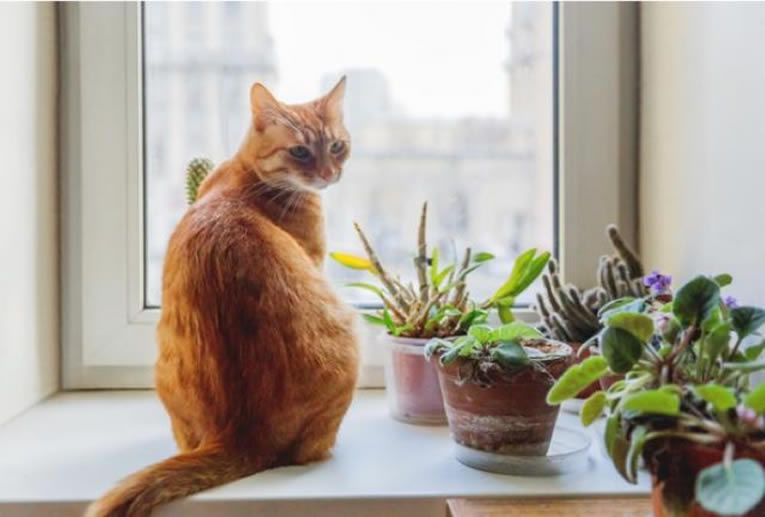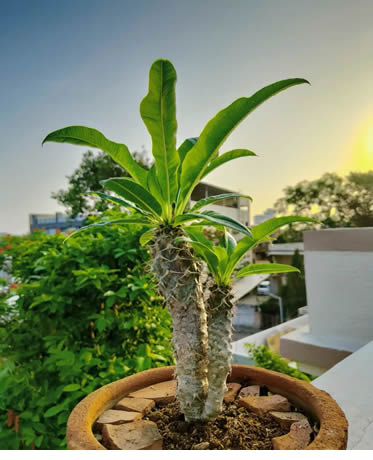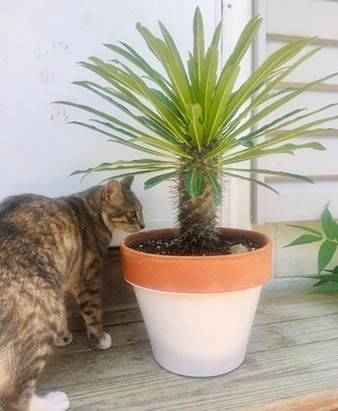Are Madagascar Palms Poisonous To Humans, Cats & Dogs?

In this post I will address the popular succulent Madagascar Palm and answer the question, are Madagascar Palms poisonous?
Having an abundance of plant life around your property and inside your home is undoubtedly rewarding for most of us in a range of ways. Fragrant flowering plants and aesthetically pleasing greenery can make any space look, feel and smell better.
Table of Contents
- The toxicity levels of Madagascar Palms
- Madagascar Palms are poisonous to humans so children should be kept away from them
- All parts of Madagascar Palms are poisonous
- The common side effects of Madagascar Palm poisoning
- How to protect loved ones from Madagascar Palm poisoning
- Madagascar Palms are toxic to cats
- Madagascar Palms are also toxic to dogs
The toxicity levels of Madagascar Palms
But, many common plants can be toxic or poisonous in many cases, necessitating that plant owners ensure the appropriate safety measures for both themselves and their beloved pets.
I have covered several common plants that are toxic on this website but what about the toxicity levels of the Madagascar Palm?
Madagascar Palms are poisonous to both humans and animals since all plant parts contain toxic sap.
Not just ingesting the plant is dangerous.
It’s dangerously sharp and large spikes can penetrate the skin, resulting in an array of issues.
Immediate medical assistance and treatment are necessary to evade dismal outcomes if the plant is ingested and most common pets should be kept well away from Madagascar palms.

Whether you have beloved pets, curious children, or others who roam and occupy the area, ensuring the appropriate safety measures when in the proximity of Madagascar Palms will be indispensable.
Although the Madagascar Palm is not as toxic as many other plants, there are still various risks involved for those who care for this plant.
Stick around to find out how Madagascar Palms can be poison to you and your specific pet, as well as how to ensure the safety of your companions while caring for this beautiful succulent.
Madagascar Palms are poisonous to humans so children should be kept away from them
As you will see later most pets do not fare well when they get too close to Madagascar Palms.
So, if you have little ones in your home then you will want to know if those toxicity levels are the same for humans.
Madagascar Palms are poisonous to humans, especially if ingested.
The poisonous sap can also be introduced to a human’s system via a puncture wound from the plant’s spikes.
It is always advised that you wear appropriate gardening gloves when handling Madagascar Palms.
The sharp spikes primarily result in more trouble for humans than does ingesting the plant.
Where animals are more at risk from munching on the foliage, or rubbing against the trunk of the plant, with humans the danger lies in touching and handling Madagascar Palms.
The spikes on the plant offer an excellent delivery system for the poisonous sap and just one prick from one spike can be enough to cause a serious reaction in some people.
The plant’s overall appearance often acts as a deterrent to curious children making it less likely that they will handle the plant – those spikes are very off-putting.
However, it is still best to ensure safety measures are taken to keep unsuspecting humans away from the plant.
Don’t place your Madagascar Palms in areas were people can brush against them accidentally.
The spikes can actually penetrate the skin quite deeply, and you will also need to keep this in mind when handling it and placing it within your home or yard.
It typically takes a few weeks before the side effects of Madagascar poisoning begin to clear up with treatment, and lack of treatment may lead to a worsened condition.
And, it’s not just the sap you need to be wary of.
In some cases, people have been pricked by the spikes, which have left slivers behind beneath the skin’s surface.
These slivers are incredibly challenging to remove altogether.

They may cause damage to the area that will need medical assistance to treat and remove if the skin begins growing over the area.
Even puncture wounds, cuts, and even minor abrasions that did not result in sap poisoning can results into bacterial or fungal infections without proper treatment.
The body’s immune response will likely result in itching and swelling, especially if there are still any spike remnants left below the skin’s surface.
Being poisoned by a Madagascar Palm is not generally fatal for humans.
However, it can lead to severe deformations or issues with tissue, skin, joints, or tendons, depending on where the puncture occurred and the severity of the injury.
All parts of Madagascar Palms are poisonous
Madagascar Palms are commonly used potted plants, both indoors or outdoors.
Madagascar palms are often found indoors during the colder winter months. Here they can present real problems for children and pets that would not be able to get access to them outdoors.
This plant species is toxic for anyone who consumes its physical parts, including the leaves and any secretions that may be evident.
But consuming it is not the only way you can be negatively affected by its poison.
The Madagascar Palm succulent has hazardously sharp tri-tipped spines approximately 2.5 inches in size, which extend from its stem or trunk.
Poison can be introduced into your system, or that of a pet, via a puncturing of the skin from these spikes.
These spikes are particularly concerning since it is much easier to avoid consumption than is is to avoid brushing past the plant or making contact with it.
These spikes can prick and penetrate the skin with enough pressure, and minor cuts may become infected if not treated quickly.
The sap secreted by the Madagascar Palm is poisonous since it contains toxic glycosides, which behave similarly to digitalis.
All parts of the Madagascar Palm contain latex, milky sap and are toxic to both human beings and animals.
The presence of these poisonous compositions is familiar amongst succulent plant species, and the Madagascar Palm’s close cousin, the desert rose, also contains these glycosides.
The sap of the Madagascar Palm is so potent and potentially lethal that it was used during the weapon creation process in ancient times for its deadly qualities.
Old civilizations would utilize this sap upon arrows’ heads, making them both dangerous for battle and effective for hunting.
It is highly recommended that you use appropriate gardening gloves when repotting. They are also essential when pruning Madagascar Palm, as just one puncture wound can be enough to cause serious health issues for some very susceptible people.
The common side effects of Madagascar Palm poisoning
Effects that victims would suffer due to the poison from this Madagascar Palms will vary depending on various factors.
However, commonly exhibited side effects include diminished appetites, fatigue, irregular heartbeat, nausea, vomiting, and diarrhea.
In some cases, being poisoned by this plant can be fatal if the poisonous say is consumed in high quantities.
Anyone who has been poisoned will need immediate medical assistance.
How to protect loved ones from Madagascar Palm poisoning
The best way to ensure that no harm comes to any of your loved ones, whether it be pets or human family members, is to keep Madagascar Palms separated from the dwelling space.
This is not the best plant species to have in a family or pet-friendly garden or room. Madagascar Palms should always be placed away from any ordinary activity.
If you plan to place this unique plant in your home as a houseplant ensure it is kept well away from animals, children and unsuspecting adults.
Placing it on a shelf or windowsill that gets plenty of direct sunlight will be beneficial to both the plant and everyone else.
However, be aware that these will not stop cats from accessing the plant.
So, if you are cat owner I would strongly suggest you do not populate your home, either indoor or outdoor, with Madagascar Palm.
There are much friendlier alternatives for pets.
Madagascar Palms should never be pruned in the presence of pets or children, as stray debris and plant matter may still make contact with them incidentally.
Madagascar Palm owners may also opt to put up fencing and barriers around the plants to ensure that pets do not wander in the area.
In some cases, particularly once the Madagascar Palm has matured, plant owners may choose to cut off the spikes completely to alleviate many hazardous risks.
While this plant is undoubtedly fascinating and alluring, it can be too alluring for curious pets and young ones (see our guide to pruning Madagascar Palms).
Even a small prick from a Madagascar Palm spike can lead to far more severe issues over time, and plant enthusiasts definitely need to pay close attention to the potential risks.
It can be troubling to care for a Madagascar Palm at home, considering its risks.
But, if you are careful in the placement of your plants you will still be able to ensure the safety of everyone around the plant while enjoying the unique and lovely aesthetics this palm-lookalike succulent has to offer both home and garden.
Madagascar Palms are toxic to cats
So we’ve seen that Madagascar Palm can be hazardous to human beings but these hazards don’t just stop at humans.

Madagascar Palms are poisonous to cats. In fact this plant is much more detrimental to felines than most other species.
While the spikes may deter them from venturing too close, cats may still curiously lick or gnaw on leaves and flower.
This action will likely lead to severe health repercussions and negative side effects.
In some cases it can even result in the death of the animal.
A cat who has ingested foliage from a Madagascar Palm may experience severe side effects.
Likewise if the cat sustains wounds from the spikes, or existing wounds become infected from contact with the plant, it can be very bad for your cat.
Keep your feline friends away from Madagascar Palms.
Injuries and infection can occur if the cat brushes against the trunk or even runs past the plants abrasively while it has an open wound or cut.
More severe injuries may harm the cat’s nose, face, eyes, or mouth, especially if the cat attempts to nibble on the plant’s leaves.
Likely symptoms would be diarrhea, a lack of appetite or vomiting, lethargy and an unwillingness to move and in severe cases your cat could have an irregular heartbeat and even die.
Madagascar Palms are also toxic to dogs
So cats should never be allowed to go anywhere near your Madagascar Palms but what canines?
Madagascar Palms are poisonous to dogs.
Dogs will often chew on plant leaves and thus ingest the poisonous sap of the plant.
This will often result in diarrhea, a lack of appetite, vomiting, lethargy and in severe cases the dog could have an irregular heartbeat and even die.
Madagascar Palms are poisonous for dogs as well, although the plant’s appearance may deter them.
The risk may be slightly lower than cats since dogs are less likely to rub their bodies against the plant.
But, dogs may still sniff and chew on the plant’s leaves and extremities or make contact with it while marking their territory. This will have harmful side effects on the animal similar to those experienced by cats.
Thanks for reading! I'm Michael — houseplant fanatic and your Pinterest plant guide.
Follow me on Pinterest for fresh updates 🌿



